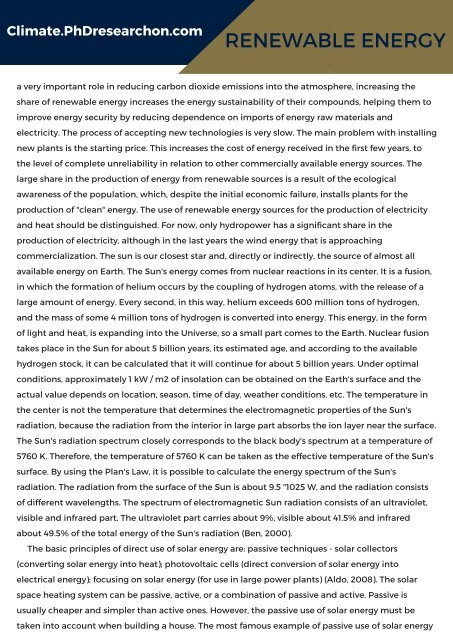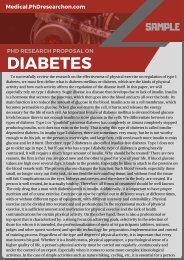PhD Research Thesis on Renewable Energy Sample
Good news! We have prepared for you a new PDF about PhD research thesis, read more http://climate.phdresearchon.com/
Good news! We have prepared for you a new PDF about PhD research thesis, read more http://climate.phdresearchon.com/
Create successful ePaper yourself
Turn your PDF publications into a flip-book with our unique Google optimized e-Paper software.
Climate.<str<strong>on</strong>g>PhD</str<strong>on</strong>g>research<strong>on</strong>.com<br />
RENEWABLE ENERGY<br />
SAMPLE<br />
a very important role in reducing carb<strong>on</strong> dioxide emissi<strong>on</strong>s into the atmosphere, increasing the<br />
share of renewable energy increases the energy sustainability of their compounds, helping them to<br />
improve energy security by reducing dependence <strong>on</strong> imports of energy raw materials and<br />
electricity. The process of accepting new technologies is very slow. The main problem with installing<br />
new plants is the starting price. This increases the cost of energy received in the first few years, to<br />
the level of complete unreliability in relati<strong>on</strong> to other commercially available energy sources. The<br />
large share in the producti<strong>on</strong> of energy from renewable sources is a result of the ecological<br />
awareness of the populati<strong>on</strong>, which, despite the initial ec<strong>on</strong>omic failure, installs plants for the<br />
producti<strong>on</strong> of "clean" energy. The use of renewable energy sources for the producti<strong>on</strong> of electricity<br />
and heat should be distinguished. For now, <strong>on</strong>ly hydropower has a significant share in the<br />
producti<strong>on</strong> of electricity, although in the last years the wind energy that is approaching<br />
commercializati<strong>on</strong>. The sun is our closest star and, directly or indirectly, the source of almost all<br />
available energy <strong>on</strong> Earth. The Sun's energy comes from nuclear reacti<strong>on</strong>s in its center. It is a fusi<strong>on</strong>,<br />
in which the formati<strong>on</strong> of helium occurs by the coupling of hydrogen atoms, with the release of a<br />
large amount of energy. Every sec<strong>on</strong>d, in this way, helium exceeds 600 milli<strong>on</strong> t<strong>on</strong>s of hydrogen,<br />
and the mass of some 4 milli<strong>on</strong> t<strong>on</strong>s of hydrogen is c<strong>on</strong>verted into energy. This energy, in the form<br />
of light and heat, is expanding into the Universe, so a small part comes to the Earth. Nuclear fusi<strong>on</strong><br />
takes place in the Sun for about 5 billi<strong>on</strong> years, its estimated age, and according to the available<br />
hydrogen stock, it can be calculated that it will c<strong>on</strong>tinue for about 5 billi<strong>on</strong> years. Under optimal<br />
c<strong>on</strong>diti<strong>on</strong>s, approximately 1 kW / m2 of insolati<strong>on</strong> can be obtained <strong>on</strong> the Earth's surface and the<br />
actual value depends <strong>on</strong> locati<strong>on</strong>, seas<strong>on</strong>, time of day, weather c<strong>on</strong>diti<strong>on</strong>s, etc. The temperature in<br />
the center is not the temperature that determines the electromagnetic properties of the Sun's<br />
radiati<strong>on</strong>, because the radiati<strong>on</strong> from the interior in large part absorbs the i<strong>on</strong> layer near the surface.<br />
The Sun's radiati<strong>on</strong> spectrum closely corresp<strong>on</strong>ds to the black body's spectrum at a temperature of<br />
5760 K. Therefore, the temperature of 5760 K can be taken as the effective temperature of the Sun's<br />
surface. By using the Plan's Law, it is possible to calculate the energy spectrum of the Sun's<br />
radiati<strong>on</strong>. The radiati<strong>on</strong> from the surface of the Sun is about 9.5 "1025 W, and the radiati<strong>on</strong> c<strong>on</strong>sists<br />
of different wavelengths. The spectrum of electromagnetic Sun radiati<strong>on</strong> c<strong>on</strong>sists of an ultraviolet,<br />
visible and infrared part. The ultraviolet part carries about 9%, visible about 41.5% and infrared<br />
about 49.5% of the total energy of the Sun's radiati<strong>on</strong> (Ben, 2000).<br />
The basic principles of direct use of solar energy are: passive techniques - solar collectors<br />
(c<strong>on</strong>verting solar energy into heat); photovoltaic cells (direct c<strong>on</strong>versi<strong>on</strong> of solar energy into<br />
electrical energy); focusing <strong>on</strong> solar energy (for use in large power plants) (Aldo, 2008). The solar<br />
space heating system can be passive, active, or a combinati<strong>on</strong> of passive and active. Passive is<br />
usually cheaper and simpler than active <strong>on</strong>es. However, the passive use of solar energy must be<br />
taken into account when building a house. The most famous example of passive use of solar energy





